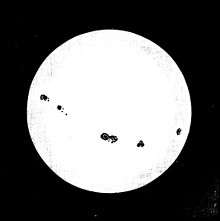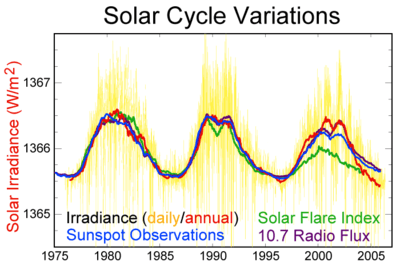Solar cycle 12
| Solar cycle 12 | |
|---|---|
 Sunspots recorded during solar cycle 12 (1 September 1883). | |
| Sunspot data | |
| Start date | December 1878 |
| End date | March 1890 |
| Duration (years) | 11.3 |
| Max count | 124.4 |
| Max count month | December 1883 |
| Min count | 3.7 |
| Spotless days | 736 |
| Cycle chronology | |
| Previous cycle | Solar cycle 11 (1867-1878) |
| Next cycle | Solar cycle 13 (1890-1902) |
Solar cycle 12 was the twelfth solar cycle since 1755, when extensive recording of solar sunspot activity began.[1][2] The solar cycle lasted 11.3 years, beginning in December 1878 and ending in March 1890. The maximum smoothed sunspot number (SIDC formula) observed during the solar cycle was 124.4 (December 1883), and the starting minimum was 3.7.[3] During the minimum transit from solar cycle 12 to 13, there were a total of 736 days with no sunspots.[4][5][6] A very bright blood-red aurora display happened over New York on 16 April 1882, while significant communication disturbances occurred.[7] A geomagnetic storm later in that year produced the aurora of November 17, 1882.
See also
References
- ↑ Kane, R.P. (2002). "Some Implications Using the Group Sunspot Number Reconstruction". Solar Physics 205(2), 383-401.
- ↑ "The Sun: Did You Say the Sun Has Spots?". Space Today Online. Retrieved 12 August 2010.
- ↑ SIDC Monthly Smoothed Sunspot Number. ""
- ↑ Spotless Days. ""
- ↑ What's Wrong with the Sun? (Nothing) more information: Spotless Days. ""Archived copy". Archived from the original on 14 July 2008. Retrieved 12 July 2017. "
- ↑ Solaemon's Spotless Days Page. ""
- ↑ http://www.solarstorms.org/SRefStorms.html
This article is issued from
Wikipedia.
The text is licensed under Creative Commons - Attribution - Sharealike.
Additional terms may apply for the media files.
